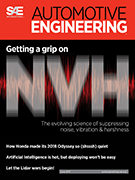Research Report
Unsettled Topics Concerning the Impact of Quantum Technologies on Automotive Cybersecurity
2020-12-10
EPR2020026
What standardization is needed to ensure that quantum technologies do not pose an unacceptable risk from an automotive cybersecurity perspective? Click here to access the full SAE EDGETM Research Report portfolio.




